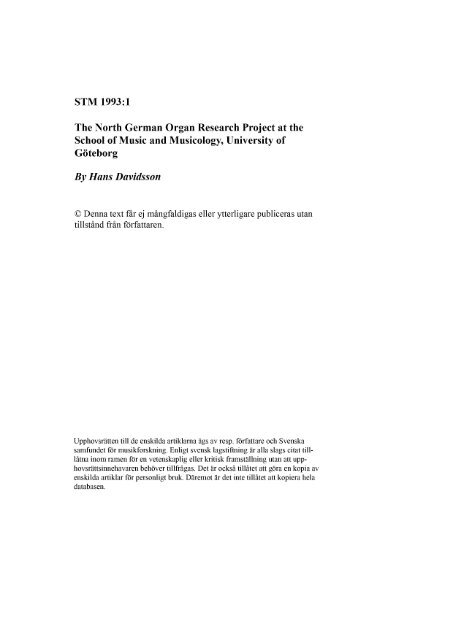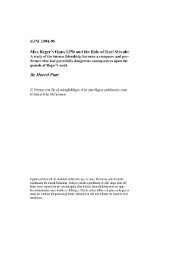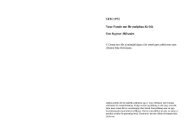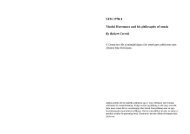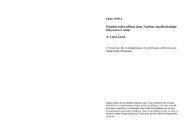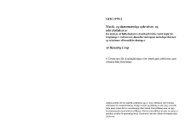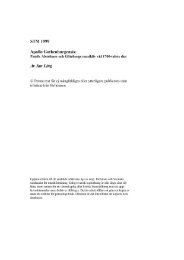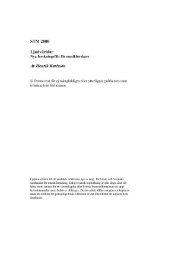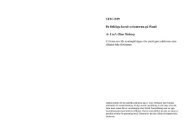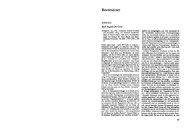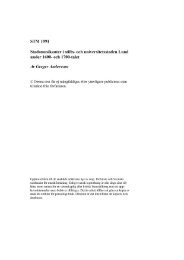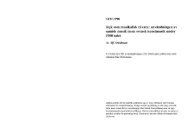Untitled - Svenska samfundet för musikforskning
Untitled - Svenska samfundet för musikforskning
Untitled - Svenska samfundet för musikforskning
Create successful ePaper yourself
Turn your PDF publications into a flip-book with our unique Google optimized e-Paper software.
STM 1993:1 The North German Organ Research Project 7<br />
The North German Organ Research Project<br />
at the School of Music and Musicology,<br />
University of Göteborg<br />
by Hans Davidsson<br />
I. Background and aim<br />
The School of Music and the Department of Musicology at the University of Göteborg<br />
merged into a single institution in 1985. This union has broken ground for new<br />
research focused on performance and has resulted in the development of a new program<br />
in the so-called artistic-creative research education. Jan Ling, professor of musicology<br />
at the University of Göteborg, has been responsible for this research program,<br />
which puts musicology at the service of the performer, focusing research that will illuminate<br />
the relationships between performers and the sources of historical or contemporary<br />
repertoires, and finally the relevant instruments that helped form them<br />
both. The interaction can be described with the following sketch:<br />
The first dissertations to take this approach were presented in 1991 and one of the<br />
main subjects of the research has been the North German organ culture of the Baroque.<br />
1<br />
1. Hans Davidsson, Matthias Weckmann: the Interpretation of his Organ Music, Volume One<br />
(text), Volume Two (edition), Volume Three (Double CD recording of the Complete<br />
Organ Works). Skrifter från musikvetenskapliga institutionen vid Göteborgs universitet<br />
nr 22, Ph D diss. (Stockholm: Gehrmans, 1991); Gunno Klingfors, Bach går igen - källkritiska<br />
studier i J S Bachs upp<strong>för</strong>andepraxis. Skrifter från Musikvetenskapliga institutionen<br />
vid Göteborgs universitet nr 23 (Göteborg: Ph D diss. 1991); Anders Wiklund, Eduard<br />
Brendlers opera Ryno. Skrifter från musikvetenskapliga institutionen vid Göteborgs universitet<br />
nr 25. (Göteborg: Ph D diss. 1991).
8 Hans Davidsson STM 1993:1<br />
The historical instruments themselves are the most important sources for such research.<br />
Therefore, the availability of an instrument of similar quality and tonal aesthetics<br />
is a necessity for the future development of this research. Already in the spring<br />
of 1989 we had the idea of reconstructing a Hanseatic City Baroque organ. It soon<br />
became clear that a reconstruction of such an instrument would only be possible on a<br />
scientific basis with a interdisciplinary-oriented group of organ builders involved. Professor<br />
Harald Vogel, Bremen, as a consultant, and the organbuilder Henk van Eeken,<br />
the Netherlands, were involved in the preparatory studies. In 1990 examination of<br />
metal samples from 17th-century organ pipes began at the SIMS-laboratory at Chalmers<br />
University of Technology, Göteborg. Four explorative tours to Germany and the<br />
Netherlands with a varying number of organbuilders, scientists and musicians have<br />
been made. In 1991, a joint-venture group of organ builders, who will carry out the<br />
applied part of the research and actually build the instrument, and a reference group<br />
for the project were formed. The aim is not only to reconstruct a 17th-century Hanseatic<br />
organ but also to reconstruct the historical methods of making such an instrument.<br />
These goals require a greater awareness of the different perceptions of the organ<br />
in northern Europe in the 17th and 20th centuries.<br />
The 17th Century Perception of the Organ<br />
The organ was considered the queen and the heart of all instruments in the 17th century,<br />
and the North German organs were especially renowned for their superior standards.<br />
They were, of course, also important symbols of the prosperity and power of<br />
the free Hanseatic cities. The organ itself was considered to be a symbol of the congregation,<br />
Christian life and even the Creation, and was often used allegorically as a<br />
subject for sermons and writings.<br />
Such texts describe the human being metaphorically as an organ and the Holy<br />
Ghost as the Heavenly Organist. The mouth and the tongue of man are symbolized<br />
by the mouth of a flue pipe and the tongue of a reed pipe. The Word of God is compared<br />
to the bellows that influence and drive the wind which in turn stands for the<br />
human temperament and disposition; the Heavenly Organist controls the instrument<br />
from the console, the manuals are the heart and the registers are the different Affekten,<br />
so that the human being in thought and deed achieves a “Harmony and Resonance”<br />
with the divine will.<br />
The organist was a highly esteemed person. The most talented musicians wanted to<br />
become city organists, both for the quality of the instruments and for the social status<br />
offered by this position. At that time, the Hanseatic cities were foreign and beautiful<br />
birds in a landscape of absolutism. In these cities a musician could work with much<br />
more freedom than at a court, having the possibility to function as a composer, a ca-
STM 1993:1 The North German Organ Research Project 9<br />
pellmeister and an instrumentalist in one person, in other words a musicus perfectus.<br />
The organ was thought to materialize and embody the highest standards of art, science,<br />
and technology of the time and was regularly admired publicly in services and<br />
concerts by people of all ages and social ranks. Only a few people, however, really<br />
knew how the sound was produced, how the harmony was created, and what was hidden<br />
behind the façade.<br />
The builder was thus a respected and educated person, a combination of scientist,<br />
craftsman and artist. The organ building of the time could be described from our<br />
point of view as an applied science and art, employing mathematical and geometrical<br />
models at the highest level of engineering in construction and design and, at the same<br />
time, integrating the latest aesthetical and mechanical concepts.<br />
The 20th Century Perception of the Organ<br />
In the 20th century, the organ as an instrument has played a background role in musical<br />
life in general. People have been fascinated, however, by the size of the instrument<br />
and the amount of sound that it can produce, thus taking a quantitative rather<br />
than a qualitative approach. From the composers’ point of view, the main focus has<br />
been on new sonorities, and a fascination with the number of sounds and effects a<br />
single person can control. Generally speaking, the organ has been considered a product<br />
of simple handicraft or a fixture of a building rather than a work of art or a manifestation<br />
of science.<br />
When industrialization, or semi-mass production, became predominant at the beginning<br />
of this century, a paradigmatic shift took place in organ building. The main<br />
aim was no longer to attain the highest quality possible; instead, factors such as capacity<br />
and profit became predominant. The instruments were often made in large workshops<br />
with a high degree of specialization among the employees. The view of the<br />
instrument as a whole was lost. The ideas of the time also supported an emphasis on<br />
quantity and loudness instead of quality and beauty. Quality organ builders were forced<br />
to surrender for financial reasons. Piece by piece, the accumulated experience of<br />
the skilled craftsmen disappeared. Thus the end result came to be determined more<br />
by the production process itself than by aesthetical or stylistic aims. The organists<br />
themselves were catalysts in this process because of their general attitude that the organ<br />
should be large and full of technical devices.<br />
The first reaction to this came with the “organ revival movement” which picked up<br />
certain elements from the historical organs, mixed them into a new style and integrated<br />
them in the semi-mass production process of organ building. This new style, although<br />
it purported to be a revival of something old, was much more a reaction against<br />
19th century aesthetical values, than a recovery of any of the important qualities of the
10 Hans Davidsson STM 1993:1<br />
historical instruments.<br />
In the late 1940s a new understanding of the value of the antique organs arose, partly<br />
induced by the early music revival. Recordings of historical instruments set new<br />
standards. Instruments were restored, and sometimes new organs were designed with<br />
a certain awareness of historical practice. A kind of underground organ-building movement,<br />
parallel to that of other so-called early instruments, was born. The International<br />
Summer Academy in Haarlem, the Netherlands, centered around the fabulous<br />
Müller organ (restored by Marcussen in 1961), and the Norddeutsche Orgelakademie,<br />
founded and conducted by Professor Harald Vogel, focused around the historical organs<br />
in Ostfriesland restored by the organbuilders Ahrend and Brunzema, both played<br />
a very important role in this development. A relatively small number of organ builders<br />
in Europe and the United States studied the antique organs and tried to recreate their<br />
standards. Factors such as the following were emphasized and reevaluated: scalings of<br />
pipes, tracker action, suspended action, solid materials, organ case, pipe-metal alloy,<br />
tuning and temperament, wind chest layout, wind supply, pipe construction and,<br />
more recently, acoustical behavior of pipes.<br />
The Problem<br />
All these factors turned out to be important for the quality of the instruments. But the<br />
overall result of the instruments built was not satisfactory when compared to the antique<br />
organs. Among the many reasons for this situation, there are five in particular that<br />
I would like to mention: 2<br />
1. The 20th-century view often promotes a focus of attention on isolated factors,<br />
while deterring an investigation of how these factors interact with one another in<br />
an organic whole. A resulting mistake was the assumption that there was a “universal<br />
key” that would solve all the problems. The idea of such a universal secret<br />
came to determine much individual research carried out especially by organ consultants,<br />
thereby establishing themselves as specialists. 3<br />
2. The general preconception that the 20th century is superior to earlier times prevented<br />
an objective approach and generated an automatic tendency to “improve”<br />
historical solutions without sufficient evaluation of their qualities.<br />
3. Builders and experts have not shared experience, results and ideas with each other<br />
sufficiently. Organ builders still work in the spirit of the guild system, keeping<br />
2. Professor Harald Vogel, Norddeutsche Orgelakademie, Bunde, Germany, has given me<br />
many valuable aspects on this matter.<br />
3. See for example Herbert Schulze, Karl Theodor Kühn: Orgel-Projekte 1942–1978.<br />
(Berlin : Karl H. Heusser Verlag, 1979). My thanks to Harald Vogel who drew my attention<br />
to this work.
STM 1993:1 The North German Organ Research Project 11<br />
their knowledge for themselves, and organ specialists follow the 19th-century<br />
ideal of the artist and scientist as necessarily independent and self-sufficient.<br />
4. There has not been enough input of scientific research into the development of<br />
organ building. Studies have focused on technical problems while ignoring the<br />
musical perspective. Important factors of construction have not been observed<br />
and their interaction has been disregarded.<br />
5. The application of modern semi-mass production on the process of making organs<br />
is in many ways contrary to the production of high quality equal to that of<br />
the antiques.<br />
The development in 20th-century organ building has gradually brought us to an awareness<br />
that the average quality of antique organs was much higher than that of modern<br />
instruments. This is the departure point for the North German organ project. Our<br />
central hypothesis is this: if we create the instrument using exclusively historical building<br />
methods and practices, we shall attain a level of quality that will be comparable<br />
to that of the 17th-century instruments. The project thus has two main goals:<br />
1. To reconstruct an organ that will enable us to experience the North German organ<br />
repertoire in the aesthetic environment, both tonal and physical, that inspired<br />
this literature in the first place.<br />
2. To reconstruct the 17th-century building process of these organs.<br />
II. Standpoint of the Research<br />
The 20th-century perspective on the organ outlined above can be traced in a majority<br />
of the studies made so far. This main-stream view is characterized in an article on material<br />
science from 1987 as follows:<br />
Bau und Funktion einer Orgel unterliegen sehr unterschiedlichen Anforderungen:<br />
– Der Musiker wünscht sich ein möglichst vielseitiges (sehr großes) Instrument mit<br />
strahlend hellem Klang, auf dem er die dem momentanen Geschmack entsprechende<br />
Orgellitteratur spielen kann.<br />
– Der Auftraggeber möchte eine möglichst große, aber preiswerte Orgel, die schön<br />
aussieht und möglichst silbern glänzende Orgelpfeifen besitzt, die sich nicht verändern.<br />
– Der Orgelbauer möchte eine seiner Tradition verhaftete Orgel entwerfen und aufstellen,<br />
die in Größe, Form und Klang den räumlichen Gegebenheiten angepaßt ist. 4<br />
4. Klaar, Burchard, “Über die Mikrostruktur historischer und neuzeitlicher Zinn-Blei-<br />
Orgelpfeifenlegierungen.” (1987), 245.
12 Hans Davidsson STM 1993:1<br />
1. Musicians´ Point of View<br />
The main-stream opinion is that the organist wants as large an instrument as possible<br />
which will be versatile enough to serve equally well for all repertoires.<br />
During the last few decades, however, there has been a fundamental change in awareness<br />
of quality of sound, stylistic orientation, and the relationship between repertory<br />
and instrument. The superior functioning of the historical instruments in liturgical<br />
settings has also been pointed out, and basic “sound concepts” of modern instruments<br />
have finally been called into question.<br />
This ongoing paradigmatic shift in the art of organ building and playing is still a<br />
fluid thing, not yet having firmly established a new set of ideas about what “sound<br />
quality” is and what the new accepted comprehensive view of the instrument will be.<br />
Some of the factors that may have impeded such a development have been mentioned<br />
above. Frequently one encounters either the opinion that the highest quality can be<br />
achieved if only the voicer is good enough (the “mystery” of voicing) or the opinion<br />
that the sound must be good, if the instrument is carefully copied in all measurable<br />
respects. Recent studies and practice dispute such ideas, which are influenced by the<br />
outlook of the nineteenth century.<br />
2. Organ Builders´ Point of View – Stability and Construction<br />
During the post-war period discussions and studies were limited to measurable factors,<br />
such as the proportion of tin in pipe metal-alloys, the stability of pipes, the cost<br />
of production, the delay in electric and pneumatic actions compared to mechanical<br />
ones, 5 the touch of the tracker organs compared to that of the piano (heavy or easy)<br />
5. Caddy and Pollard (1957): The resulting oscillograms show significant differences in the<br />
initial transients: the mechanically operated pallet produces an neatly rounded figure of<br />
the initial transient, in contrast to the ragged irregular appearance of the electrically operated<br />
pallet. Moreover, independent listening tests favoured the sound of the mechanical<br />
action. Another experiment, in which the “electric” pallet was operated slowly by hand<br />
gave a result fairly similar to that of the mechanical action. From this the authors conclude<br />
that the difference in initial sound should be ascribed solely to the difference in pallet<br />
valve opening speed whereas the existence of a note channel in the mechanical system<br />
is of negligible importance. This latter conclusion is questioned by Finch and Nolle<br />
(1968). In his study “Time Delay Effects in the Operation of an Organ Pipe” (1968), Pollard<br />
has carried out experiments on real organs with different action systems (mechanical,<br />
Barker, electro-pneumatical and electric) instead of specially constructed laboratory devices.<br />
The aim is to conlude what degree of delay may be regarded as acceptable to the performer<br />
(defined as initial delay, rising time and total starting time). Two different<br />
mechanical organs have been used for the measurements, called “old mechanical” and<br />
“new mechanical” respectively. Unfortunately no other information is given as to their<br />
age. A systematic method to measure and describe the characteristics of different mechanical<br />
systems has to be developed. This can also be seen in a recent study by Kostek/<br />
Bozena (1992), in which mechanical and electrical actions are examined in order to build<br />
up an equivalent electrical circuit of an organ action. It is stated that one can conceive a<br />
computer modelling system with a kind of electronically controlled keyboard, ensuring<br />
the quality of sound similar to organs with the mechanical actions.
STM 1993:1 The North German Organ Research Project 13<br />
and the consequence of the concept compared to the established Neo-Baroque style<br />
in terms of specification, the so-called “Werkprinzip” and the absence of nicking in<br />
the voicing technique. 6 Research on organ pipes has focused on the fear of collapse<br />
and the wish to use cheaper material. 7 Only rarely are factors of sound taken into consideration.This<br />
focus can clearly be detected in articles written up until today. Most<br />
of the articles written on the topic of organs discuss problems not from an aesthetical<br />
point of departure but from the perspective of the semi-mass production.<br />
Consequently, tin-rich alloys dominate in the metallurgical studies, and the eutectic<br />
alloy is considered to be the ideal. In practice, tin-rich alloys were considered to be<br />
superior to others; this idea might also emanate from the implicit assumption that<br />
more expensive materials would give a superior quality.<br />
Nowadays most organists will tell you that tin is good, lead is not, and zinc is something<br />
one tries not to talk about! …the popular assumption that the more expensive<br />
metal produces the better sound. 8<br />
From the 1970s and onwards some studies refer occasionally to historical construction<br />
methods. With the help of material science it is shown, for example, that points of great<br />
stress occur on the sides of the mouth area of the pipe, 9 which could be overcome<br />
with historically inspired simple methods of construction, such as varying the thickness<br />
of the metal from the mouth to the top and thereby reducing the amount of tin<br />
drastically.<br />
Some American organ builders, however, were aware of the relation of the material<br />
to the sound. Charles Fisk described the differences between lead and tin pipes 10 according<br />
to their actual quality of tone production. Lead pipes, which had been almost<br />
completely ignored in modern organ building, were re-examined, primarily for musical<br />
reasons, and employed by a small number of builders, of whom John Brombaugh<br />
6. New standards for the modern organ building were set by Sybrandt Zachariassen about<br />
1940. His concept was based on slider chests, tracker action and historical scaling, a combination<br />
that was considered to guarantee the quality of the instruments. Other factors<br />
concerning the pipework, such as flue, cut-up and wind pressure, were not based on historical<br />
evidence, or at least not combined in a historically-informed manner.<br />
7. See for example Klaar/Burchard (1987), “Sometimes the mechanical stability of the historic<br />
organ-pipes is better than that of the modern pipes…,” 259; Greunke (1984: 108);<br />
Kluge (1980), Kluge (1981; this article also takes sound quality into concern), Lewis<br />
(1974:772).<br />
8. Fisk, “Some thoughts on pipe metal” (1986).<br />
9. Kluge, “Die statische Festigkeit von Orgelpfeifen.” (1980).<br />
10. Fisk, “Some thoughts on pipe metal,” (1986:124). “Raw lead is a plain-sounding material<br />
that imparts no marked overtone structure to the tone of a pipe, whereas tin adds a sheen<br />
of overtones which, under the right circumstances, produces a tone of explicit elegance.”<br />
Charles Fisk, “How certain...”, (1986:128).
14 Hans Davidsson STM 1993:1<br />
was the pioneer. Experiments with Pb-rich alloys showed that almost pure lead with<br />
a certain degree of trace elements is very stable and shows almost no creeping. 11 The<br />
possible influence of ageing on the microstructure and the mechanical properties was<br />
discussed and heating was proposed as an artificial method for new model pipes. The<br />
ancient methods of casting 12 and work hardening were subject for deliberation. 13 A<br />
study of the microstructure of historic and modern Sn-Pb organ pipe alloys argues<br />
that a conscious choice of metal composition, casting procedure, cooling rate and construction<br />
can lead to improved stability. 14<br />
The historically-oriented organ building brigade managed very well with the technical<br />
part of the construction, and the degree of perfection of the woodwork, for example,<br />
was higher than the standards of the historical instruments. The copying of the<br />
pipework was not always as succesful. The American movement was characterized by<br />
a more eclectic approach, which often paid more attention to the sound and touch of<br />
the instruments than to the authenticity of materials.<br />
3. The Aspect of Complexity<br />
A general problem with organ pipe studies so far has been that the properties of the<br />
pipes examined have not been described in enough detail. Moreover, in almost all cases<br />
only modern pipes have been studied. The influence on the sound exerted by details<br />
in construction and the mechanical properties of the materials themselves are<br />
often not taken into consideration, despite the fact that a relationship between construction<br />
material and sound quality was demonstrated as early as 1961. 15 Johan Sundberg´s<br />
thesis from the 1960s is one of the earliest of the few studies aware of the<br />
difference in behavior between modern and antique pipes. 16 Charles Fisk described<br />
11. In recent years, there has been a growing interest in duplicating the kind of Principal and<br />
Flute tone produced by the almost pure lead pipes which were made by Arp Schnitger´s<br />
predecessors, and often preserved by him when he rebuilt earlier organs. That kind of<br />
tone seems to require high lead-content pipes and to be unobtainable from higher tin<br />
alloys. Herman Greunke, “The Structural Stability of Lead-Tin Alloys used in Organ-<br />
Pipes.” The Organ Year Book (1986:108).<br />
12. See: Morgan (1982).<br />
13. See: Kluge (1981) and Pootvliege (1978).<br />
14. See: Klaar/Burchard (1987); No quantification of the elements in the historical alloy is<br />
done. The authors do not exclude a possible influence on the sound of the parameters studied.<br />
See also: Gifkins (1973).<br />
15. Lottermoser and Meyer, “Über den Einfluß des Materials auf die klanglichen Eigenschaften<br />
von Orgelpfeifen” (1962). The influence of material on the sound as an important<br />
factor is denied by Yoshikawa in “Energy Dissipations in Underwater and Aerial Organ<br />
Pipes” (1985). However, the author does not take into consideration a difference between<br />
historical and modern pipes in his calculations.<br />
16. Johan Sundberg, Metodologiska problem vid analys av orgelklang, Diss. Uppsala universitet,<br />
1963. See also: Plomp and de Laat, “Comparisons of Organs in a Spectrum Space”<br />
(1984), which compares the sound spectra of plenos (principals and mixtures) in 14 different<br />
organs from different epoches, from the 17th century to 1950 and, among many<br />
other things, shows a striking similarity in the spectra of the three 17th century North<br />
German organs, indicating that these organs have common sound characteristics that distinguish<br />
them from other 17th century organs as well as from later instruments.
STM 1993:1 The North German Organ Research Project 15<br />
the intimate relation between the pipe and the note channel and stated his awareness<br />
of the un-known factors that determine the quality of the organ sound.<br />
Ah, the note channel – what mysteries lie hidden in that small medieval tunnel! Organ<br />
sound is conceived in the note channel, born in the pipe. Half the troubles in an<br />
organ seem to originate in the note channel, and yet, so also do a thousand unknowable,<br />
dissertation-worthy intricacies that help make of the organ the instrument we<br />
find so irresistible. 17<br />
In 1986 Finch and Nolle stated that oscillations produced by the reflections of air<br />
pressure waves in an organ note channel may under certain conditions cause fluctuations<br />
in the initial sound output of the pipe. 18 The complex interaction between all<br />
the factors influencing the organ sound, which the organ builder in the 17th century<br />
knew, is taken into full consideration by Munetaka Yokota in his article on the Chico<br />
organ in The Historical Organ in America (1992).<br />
Some historical records indicate that the voicing of the organ pipes was a much easier<br />
job for the old masters and could be done without our modern voicing “tricks” or<br />
“aids,” and that these old pipes have very natural and musical speech…wide latitude<br />
of usable speech even under the various speeds of wind pressure increases. 19<br />
Through experiments that consider all factors important for the generation of sound,<br />
Yokota has observed that the quality and beauty of sound are achieved when the factors<br />
are combined in such a way that a “dynamically balanced art is created.” 20<br />
If materials are chosen on the basis of their acoustical properties and if their inherent<br />
nature is respected, the materials themselves will determine the dimensions and construction<br />
appropriate to them… style is the result of a subtle but powerful interaction<br />
between the craftsman, or builder, and the environment. 21<br />
When principles of construction from different periods are combined “unharmoniously”<br />
or even when one is exaggerated in relation to the others, the organic balance<br />
is lost and the end result is inferior. The sound result is uninteresting or in the worst<br />
case, the instrument does not even work. Some characteristics of Silbermann pipes are<br />
pointed out. 22 The tapered and relatively thin material that Silbermann used (thicker<br />
17. Fisk, “How certain...” (1986:132).<br />
18. Finch and Nolle, “Pressure Wave Reflections in an Organ Note Channel” (1986).<br />
19. Yokota, “California State University, Chico, California, Munetaka Yokota, Opus 2,<br />
1990.” In The Historical Organ in America, A Documentary of Recent Organs Based on<br />
European & American Models, edited by Lynn Edwards. Easthampton, Massachusetts: The<br />
Westfield Center for Early Keyboard Studies, (1992:102).<br />
20. Yokota, ibid., (1992:101).<br />
21. Yokota, ibid. (1992:101).<br />
22. Silbermann pipes also serve as references in Kluge (1975) and in Klaar/Burchard (1985).<br />
In both of the articles a possible influence of factors as construction, material and dimensions<br />
on the sound are assumed and the word “beauty” in the sense of a superior quality, is<br />
used to describe these pipes.
16 Hans Davidsson STM 1993:1<br />
at the mouth end of the pipe and thinner at rest of the body) and its mechanical properties<br />
make the pipe body more resonant. In such a pipe wall vibrations can be observed<br />
in the upper part of the body. 23 While holding, tapping, or blowing such a<br />
pipe, one experiences that the tone is actually living in the pipe itself. It seems as if<br />
there is a certain harmonious relation between the acoustical resonance and the vibration<br />
resonances. Such a balance should characterize the whole concept so that<br />
all pipes speak at their most natural point, they balance and blend superbly and yet<br />
express a distinct personality of their own, the performer´s interpretation can be sensitively<br />
expressed through touch, sufficient and well-behaved wind create musical<br />
“bloom” for each note or chord without quick chattering or choking, every part or<br />
the organ assists the pipes acoustically. 24<br />
A similar balance of compatible elements characterizes a living performance of the<br />
music of the time. The extrinsic level of a 17th-century organ composition, such as<br />
registration (sonority), tempo, and proportion, has to correlate to the intrinsic level of<br />
figures, motives, and ornaments. When the performer finds the optimal balance by<br />
the technical means of articulation, phrasing and rhetorical gestures, the performance<br />
gains beauty, character, and a continual breath of contrasting elements, on microlevel<br />
and macrolevel respectively. 25 Studies of musical performance by computer modeling<br />
have shown a similar interdependence of musical means of expression and the texture<br />
of the composition. 26<br />
III. The Göteborg Method of Research<br />
The main part of the research within the project will concentrate on the pipework, the<br />
part of the instrument that primarily sounds. The research on organ pipes will focus<br />
on the properties, construction, and acoustical behavior of the antique pipes. All the<br />
factors that influence the quality of the sound should be studied in their complex interaction<br />
within the historical models. Relevant wind-supply systems (and extant<br />
parts), wind chests, actions and action components will be measured as well as case<br />
work. The measurements will be evaluated and compared with theoretical calculations<br />
and model experiments. Such a working method requires an interdisciplinary ap-<br />
23. In Yoshikawa, “Energy Dissipations in Underwater and Aerial Organ Pipes” (1985), wall<br />
vibrations and sound radiation from the wall are stated to be negligible factors for the<br />
sound generation in an [aerial] organ pipe, irrespective of pipe material. However, the author<br />
does not take into consideration a difference between historical and modern pipes in<br />
his calculations.<br />
24. Yokota, ibid. (1992:101).<br />
25. Davidsson, ibid., pp. 45-82.<br />
26. J. Sundberg, A. Friberg, L. Frydén: “Common Secret of Musicians and Listeners: An Analysis-by-synthesis<br />
Study of Musical Performance.” (1991).
STM 1993:1 The North German Organ Research Project 17<br />
proach using the wide-ranging expertise of organbuilders, scientists, scholars, and musicians.<br />
It is plausible to assume that the antique instruments sounded differently in the<br />
17th century from the way they do today. The influence of tuning, restorations and<br />
sometimes more or less thorough rebuildings over the centuries has to be taken into<br />
consideration. The effect of ageing will be an important subject for the research. The<br />
research must concentrate on ancient pipework and other parts of the instrument that<br />
seem to be untouched and therefore can be assumed to be authentic. The aim of the<br />
project will be to reconstruct a Hanseatic city organ with a sound quality equal to that<br />
of the antique and well-preserved instruments of today.<br />
Field research<br />
A sufficient number of antique pipes will be examined with a special focus on their<br />
acoustical behavior. All standard measurements will be taken (circumference in different<br />
positions, mouth width, cut-up, languid thickness, angle, etc); observations of<br />
the construction in detail and the acoustical behavior (video recording) of the pipes<br />
will be made; careful measuring of the wall-thickness with an ultra-sonic device will<br />
be carried out; at the mouth area photos will be taken of the shape of the body and<br />
the languid from above and below respectively (with a fiber-optic device). A protocol<br />
which coordinates the data will be evaluated and kept as reference.<br />
The extant wind systems will be measured and examined. Initial and reflected impulses<br />
will be measured simultaneously and computer model systems will be used to<br />
create simulations.<br />
Materials<br />
Mechanical properties of organ pipe alloys and the characteristics of aging will be studied<br />
as follows:<br />
1. Microstructures of antique pipe materials will be investigated regarding macroanalysis<br />
and microstructure and recasting of alloys followed by microstructural<br />
analysis. 27<br />
2. Microstructural studies of cast modern Pb-Sn alloys with additions of trace elements<br />
(nominal compositions and materials cast with modern and ancient methods<br />
on different beds; sand, stone, wood etc).<br />
27. The preparation of Pb-rich specimens for microscopic examination has always been a difficult<br />
task because of the softness of the material. Dr. Milan Friesel has developed a partly<br />
new technique which will be described in an article (in prep). See also: Vilella (1939).
18 Hans Davidsson STM 1993:1<br />
3. Short-time annealing experiments to simulate the natural ageing that has taken<br />
place in ancient material (room temperature and elevated temperatures) will be<br />
followed by analysis of microstructure and microhardness and compared with the<br />
results from new model and ancient material. Aspects of work hardening (scraping,<br />
hammering etc. ) will be taken into consideration.<br />
4. Ultrasonic measurements will evaluate elastic modulus and internal damping.<br />
One of the main problems with this research is getting access to historical material.<br />
Most of the time, only metal samples of a square centimeter are at hand. This is a particular<br />
problem for the investigations of microhardness, elasticity, and internal damping.<br />
A special research project with the aim of developing a method for measuring<br />
the elasticity modulus and internal damping in small samples will be initiated. 28<br />
Acoustics<br />
This aspect of the research will focus on the acoustical behavior of the antique pipes<br />
and the relation between material and sound. An initial study of the relation between<br />
elasticity, internal damping, and density will be carried out through computer modeling.<br />
Experiments with materials treated in different ways (scraped, hammered, 29 varnished,<br />
30 etc.) will follow. When new pipe models are made, factors like variable wall<br />
thickness and the influence of wall vibration will be investigated.<br />
Generally speaking, sound generation in organ pipes is well understood today. 31<br />
28. So far no study concerning elastic parameters and internal friction in ancient Pb-Sn alloys<br />
has been carried out. Cf. Varkey/Padmini (1983).<br />
29. “Frietsche hat schon 1627 beim Orgelneubau in St. Ulrici zu Braunschweig einen eisernen<br />
Hammer zum Pfeifenschlagen verlangt” (Flade, E. Gottfried Silbermann. Leipzig:<br />
1953: 171). See also Kluge, “Über den Einfluß des Hämmerns auf die Festigkeit und die<br />
Klangqualität von Orgelpfeifen.” Acta Organologica, 15 (1981), 180-212. …“Thus the<br />
question as to whether, and in what degree, hammering is responsible for different tone<br />
quality, could not be definitely answered.”<br />
30. The influence of varnish is not studied so far. Yokota assumes an effect which he relates to<br />
increased hardness. See also Yokota, ibid., p.102.<br />
31. See for example: Fletcher, “Transients in the Speech of Organ Flue Pipes — A Theoretical<br />
Study” (1976), which gives a theoretical foundation of the nature of the initial transient<br />
and the factors that govern it; and Fletcher, “Jet-drive mechanism in organ pipes” (1976),<br />
which deals with the deflection of the air jet when it meets the upper lip of the organ pipe.<br />
When this happens, the jet switches between a position outside and inside the pipe. This<br />
causes an interaction with the pipe modes which produces the harmonic structure of the<br />
sound jet stream; Yoshikawa, “Harmonic generation mechanism in organ pipes” (1984);<br />
the article is a theoretical study of the physical mechanism producing harmonics (fundamental<br />
and overtones) in organ pipes and gives a theoretical foundation for the assumption<br />
that the jet offset adjustment is of great musical importance; and Sundberg (1963).
STM 1993:1 The North German Organ Research Project 19<br />
Many of the studies, however, only deal with modern pipes and are not up to date<br />
when it comes to measuring methods and technical resources. Much more advanced<br />
methods are available today which will reveal subtle differences in both sound spectra<br />
and radiation patterns as well as in vibratory patterns and organ tone generation. The<br />
speech sound analysis used should be continued and expanded with sonogram methods<br />
to study modulation as well as tone build-up and decay properties. Subjective<br />
sound quality determination will also be required because no signal analysis technique<br />
has the resolution capabilities of hearing. 32<br />
Special attention will be given to the influence of mouth form, languid angle and<br />
thickness and shape, tuned pipe material and parts, shape of the pipe-body, varnishing<br />
of the outer pipe surface, dimensions and shape of the note channel, etc. 33 The problems<br />
of the case and the acoustics of the case interior are very complex, not to mention<br />
the absorbant and resonant properties of the pipes themselves.<br />
Yokota states:<br />
…if there is a small amount of controlled wall vibration in the pipe wall, it adds<br />
charm to the sound…another important advantage…it blends superbly…[tapered]<br />
pipes sound a bit softer, they have freer, richer tone…even though single pipes are<br />
somewhat softer, the organ sound is enhanced by many such pipes sounding together…the<br />
more rigidly pipes are constructed, the more absorbing they become… 34<br />
These factors are less well understood currently because of lack of research.<br />
Acoustical scale modelling techniques must be used in the design stage according to<br />
the room. A few relevant church acoustic environments will be measured, evaluated,<br />
and then related to the room where the instrument is intended to be placed, Örgryte<br />
nya kyrka in Göteborg.<br />
Similar research programs are planned for the investigation of the wind supply and<br />
the action.<br />
The following scientists from Chalmers University of Technology are involved in the<br />
research:<br />
32. See for example: Pollard, “Feature Analysis of Musical Sounds” (1988) in which different<br />
methods of analysis are discussed. The perception of the initial transient is, according to<br />
the author, of a different nature (much faster and focusing on a few outstanding features)<br />
than the perception of the steady-state tone.<br />
33. Yokota relates the following acoustical phenomena to these factors: I. the diffusion of the<br />
sound source. II the preservation of sound energy (which minimizes sound energy absorption),<br />
III. the diversification and control of the pitches of sympathetic resonance. Yokota,<br />
ibid., p. 104.<br />
34. Yokota, ibid., p.105.
20 Hans Davidsson STM 1993:1<br />
Materials: Dr. Milan Friesel, Dept. of Physics, Chalmers University of Technology<br />
(CTH), Professor Alexander Lodding and Hans Odelius, SIMS-laboratory,<br />
Dept. of Physics and Professor Birger Karlsson, Dept. of Engineering Metals, Dr.<br />
Öjwind Davidsson, Dept. of Organic Chemistry.<br />
Acoustics: Associate Professor Mendel Kleiner and Dr. Wolfgang Kropp, Dept. of<br />
Applied Acoustics, Professor Erik Olsson, Associate Professor Bror-Arne Gustafsson<br />
and Dr. Tord Granhäll, Dept. of Thermodynamics.<br />
Responsible for the project are Professor Jan Ling and Associate Professor Hans Davidsson,<br />
School of Music and Musicology at the University of Göteborg, and as<br />
a consultant, Professor Harald Vogel, Bremen.<br />
IV. Method of Building<br />
A joint-venture research project<br />
The organ must be built by organbuilders who identify themselves with the music and<br />
craftsmanship of the 17th-century North German tradition and are used to working<br />
with an interdisciplinary research approach. Because of the special character of the enterprise,<br />
Professor Harald Vogel, the consultant for this project, has proposed a jointventure<br />
projecture. The following organ builders will be responsible for different parts<br />
of the process:<br />
Henk van Eeken: research, design, preliminary scaling, and complete drawing.<br />
Mats Arvidsson: manufacturing of all woodwork (including organ-case, bellows,<br />
wind-chests, key and stop action, console and the erection of the instrument).<br />
Munetaka Yokota: research concerning the pipe-work, final scaling, pipe-making,<br />
installment of pipes and voicing.<br />
The idea of the project is to reconstruct on a scientific basis a fully developed Baroque<br />
organ according to the philosophy of the North German builders of the late 17th century.<br />
The instrument will be built in all respects according to this tradition. Data will<br />
be assembled and evaluated as a basis for the reconstruction from several Schnitger instruments,<br />
among them: Hamburg St. Jacobi, Groningen Aa-kerk, Lüdingworth,<br />
Steinkirchen, Norden St. Ludgeri, Hamburg Neuenfelde and Zwolle. The design of<br />
the organ case will take as its point of departure the Schnitger organ (destroyed during<br />
the Second World War) in the cathedral of Lübeck. The result of the research will determine<br />
the process of making the instrument.
STM 1993:1 The North German Organ Research Project 21<br />
The following specification will be realized:<br />
Werck<br />
(CDEFGA–c''')<br />
Principal (F) 16 Quintadena<br />
16 Octava<br />
8<br />
Spitzflöht 8<br />
Octava 4<br />
Rauschpfeiff II<br />
SuperOctav 2<br />
Mixtur 6-8 fach<br />
Trommet 16<br />
Oberwerck<br />
(CDEFGA–c''')<br />
Principal 8<br />
Holzflöht 8<br />
Rohrflöht 8<br />
Octava 4<br />
Spitzfloit 4<br />
Nasatt 3<br />
Gemshorn 2<br />
Octava 2<br />
Scharff 6 fach<br />
Zimbel 3 fach<br />
Trommet 8<br />
Vox humana 8<br />
Zincke 8<br />
Rückpositiv<br />
CDE–c''' (7 Subsemitonien)<br />
Principal 8<br />
Quintadena 8<br />
Principal 8<br />
Gedact 8<br />
Octava 4<br />
Blokflöht 4<br />
Octava 2<br />
Sifflet 1 1/2<br />
Sexquialtera II<br />
Scharff 4-5 fach<br />
Dulcian 16<br />
Bahrpfeiffe 8<br />
Pedal<br />
(CD–d')<br />
Brustwerck<br />
(CDE–c''')<br />
Holtz-Principal 8<br />
Octava 4<br />
Hohlflöt 4<br />
Waldflöht 2<br />
Sexquialtera<br />
Scharff 4–6 fach<br />
Dulcian 8<br />
Trechter Regal 8<br />
Principal 16<br />
Subbaß 16<br />
Octava 8<br />
Octava 4<br />
Mixtur 5 fach<br />
Groß Posaune 32<br />
Posaune 16<br />
Dulcian 16<br />
Trommet 8<br />
Trommet 4<br />
Cornett 2<br />
Four keyboards, two tremulants, nightingale, Cimbelstern<br />
Couplers: Ow/Hw, Bw/Hw<br />
Six wedge bellows<br />
Documentation<br />
The results of the research on the different parts of the project will be published in<br />
international scientific journals during the building of the instrument. A complete documentation<br />
of the project and of the building process of the instrument, including<br />
all the results of the research and detailed drawings of the instrument, will be published<br />
when the organ is finished. The instrument is expected to be finished by the fall<br />
of 1997, and an international conference and presentation is planned for August<br />
1998.
22 Hans Davidsson STM 1993:1<br />
Applied Research Center<br />
Organ education and research has been emphasized at the School of Music and Musicology<br />
in Göteborg. The North German project is part of a plan that includes several<br />
instruments representing different styles of the main epochs of the organ art. The following<br />
instruments will also be built: a Swedish classical organ (according to the styles<br />
of Schiörlin, Wahlberg, Schwan, Gren & Stråhle 35 ) and a French symphonic organ,<br />
which will be built in all respects according to the philosophy of Aristide Cavaillé-<br />
Coll. 36 The North German and French projects are financed by Knut och Alice Wallenbergs<br />
stiftelse, <strong>Svenska</strong> Handelsbanken and Forskningsrådsnämnden <strong>för</strong> Universitet och<br />
Högskolor (FRN) in Sweden. The initial research has been made possible by financial<br />
support from Kungliga Musikaliska Akademien (the Swedish Royal Academy of Music)<br />
and Stina och Erik Lundbergs stiftelse.<br />
In the future, the University of Göteborg plans to establish an Organ Art Center<br />
with an applied research center for organs and other instruments. The focus will be<br />
on restoration, reconstruction, and the development of new methods in instrument<br />
building.<br />
General Aspects<br />
Several aspects of the North German research project have general application. When<br />
mass-production replaced handcraft, a sudden loss of accumulated experience took<br />
place, the full extent of which has hardly been realized yet. In the wake of industrialization<br />
and urbanization has followed a tendency to emphasize quantity at the cost of<br />
quality, or even to redefine “quality” in quantitative terms. In the market economy<br />
financial aspects have prevailed and qualitative factors of human life or influence on<br />
nature or environment have been more or less neglected. The theme of technological<br />
development accelerating out of the hands of the human race is well-known.<br />
The 17th-century organ builder cast the metal sheets to final, and often variable,<br />
thickness. A minimum of work was needed to select suitable pieces for particular pipes<br />
according to thickness, and the microstructure was not influenced nor weakened by<br />
any severe finishing treatment. Hand scraping and/or hammering were sometimes<br />
used to treat the surface. In modern practice, sheets that are extremely thick when<br />
35. Schiörlin and Wahlberg belonged to the so-called Linköping school of the Swedish organ<br />
building tradition, being apprentices of Wistenius. Olof Schwan belonged to the so-called<br />
Stockholm school and worked in the footsteps of Johann Niclas Cahman, whose father,<br />
Hans Heinrich, was educated in the workshop of Hans Cristoph Frietsche, his brother-inlaw<br />
in Hamburg.<br />
36. The dominating builder in France during the 19th century, whose instruments had a<br />
major influence on the repertory and were considered to be superior to others of the time.
STM 1993:1 The North German Organ Research Project 23<br />
compared to the final thickness desired are cast and then machine-planed to their final<br />
thickness. This process is considered to influence the microstructure substantially and<br />
to change the mechanical properties of the metal. Thus, from a qualitative perspective,<br />
the general modern method developed from technical and rational points of view seems<br />
to be inferior to the historical method and is even an impediment for the accomplishment<br />
of certain musical aims. New scientific models are needed, which consider<br />
complexity and context to be as important as details.<br />
The Balance of Perfection and Variation<br />
An overall dominating principle of our time is perfection and consistency, from both<br />
a functional and an aesthetical point of view. No one wants to hear recordings, for example,<br />
which are not perfect in the sense that the performer plays the right notes. The<br />
contemporary manner of listening over and over again to the same performance implies<br />
a shift towards perfection in this sense and also induces the establishment of “universal”<br />
and consistent performances. Everyone knows that a live performance is<br />
something different from a recording; it allows more spontaneity and risk-taking on<br />
the part of the performer. Despite this, the aesthetics of our time and the process of<br />
producing and listening to recordings force us to accept the demand for technical perfection.<br />
The 17th-century way of living, handcraft and art always left space for a certain element<br />
of variation, which from our perspective could be described as inconsistency. Inconsistency<br />
can be found in case work, in note channels as well as in the shape and the<br />
dimensions of the pipes. A higher degree of perfection can often be noticed when it is<br />
important for the function or an aesthetical aim. It seems as if the idea of a dynamically-balanced<br />
concept prevented the people in the 17th century from rigid accentuation<br />
of perfection. Perhaps this is also the reason why we today admire the art of that<br />
time with our minds and souls without having any social or ideological relationship<br />
to it. The use of principles based on geometry and natural proportions for the construction<br />
rather than on the linear and logarithmic functions of modern times may also<br />
contribute to the balance and beauty of the antique organs.<br />
When early fingering is used in performance of Baroque music a certain degree of<br />
variation in articulation and accentuation is achieved. Accentuation is known as the<br />
most important factor in the interpretation of 17th-century music. The combination<br />
of the performer´s intention of perfection and the historical technique results in an<br />
appealing balance within the performance.<br />
The historico-sociological aspects of the status of organ art in the 17th century may<br />
also provide important knowledge of the time. Why were these instruments brought<br />
to birth in times of war, plague, financial crisis, and political upheaval? What transna-
24 Hans Davidsson STM 1993:1<br />
tional cultural currents can be traced or reflected by the propagation of the North German<br />
organ art?<br />
It is our hope that the North German organ research project may serve as a model<br />
for interdisciplinary small-scale projects, where science, scholarship, humanities, arts<br />
and handicraft can meet, inspire and complement each other. This project represents<br />
the reconstruction of a piece of art and the manifestation of a lost musical concept<br />
both from the prenational period of Europe, when the peoples in the North were in<br />
many ways closely interrelated. It is, therefore, also a logical and not insignificant symbol<br />
of internationalization and reunion. Its primary purpose is to provide us once<br />
again with the splendid musical resources of the 17th century organ art in a monumental<br />
musical instrument, to investigate the factors which determine the generation<br />
of highly quality organ sound and to recreate the knowledge and experience of the art<br />
of organ building. We hope that the project will also contribute to a renaissance of<br />
organ building, so that the words of Athanasius Kircher (1650) also can be attributed<br />
to the organ art of the 21st century:<br />
Nothing is to be compared to the Organ and nothing is more similar to the visible<br />
world than the Organ…the Organ is a miraculous achievement of art. Who will deny<br />
/ that the art of organ building has been brought in our time to its pinnacle of perfection.<br />
37<br />
37. See Also: Davidsson, ibid., p. 18.
STM 1993:1 The North German Organ Research Project 25<br />
Literature:<br />
Bassi, P.S. ; Sharma, N.K. ; Chrawla, J.S. ; Sharma, M.K. “Mode of Solidification and<br />
Strength Properties for Lead-Tin Binary System.” Crystal Research and Technology,<br />
18, No. 5 (1983), pp. 637-640.<br />
Bayly, B. J. “Onset and equilibration of oscillations in general Rijke devices.” J. Acoust.<br />
Soc. Am., 79 (1986), 846-851.<br />
Caddy, R.S. ; Pollard, H.F. “Transient Sounds in Organ Pipes.” Acustica , 7 (1957),<br />
277-280.<br />
Finch, T.L. ; Nolle, A.W. “Pressure wave reflections in an organ note channel.” J.<br />
Acoust. Soc. Am., 79 (1986), 1584-1591.<br />
Fisk, C. B. “The Organ’s Breath of Life.” In Charles Brenton Fisk, Organ Builder, Essays<br />
in his honor, Vol. 2, pp. 113-121. Easthampton, Massachusetts: The Westfield<br />
Center for Early Keyboard Studies, 1986.<br />
Fisk, C.B. “How Certain Musical Differences Between the Historic Organs of Germany<br />
and France were Achieved by Differences in Construction.” In Charles<br />
Brenton Fisk, Organ Builder, Essays in his honor, Vol. 2, pp. 127-134. Easthampton,<br />
Massachusetts: The Westfield Center for Early Keyboard Studies, 1986.<br />
Fisk, C.B. “Pipe Flueways.” In Charles Brenton Fisk, Organ Builder, Essays in his honor,<br />
Vol. 2, pp. 121-122. Easthampton, Massachusetts: The Westfield Center for Early<br />
Keyboard Studies, 1986.<br />
Fisk, C.B. “Some Thoughts on Pipe Metal.” In Charles Brenton Fisk, Organ Builder,<br />
Volume One, Essays in his honor, Vol. 2, pp. 123-126. Easthampton, Massachusetts:<br />
The Westfield Center for Early Keyboard Studies, 1986.<br />
Fisk, C.B. “The Architect as Organ Maker” In Charles Brenton Fisk, Organ Builder,<br />
Essays in his honor, Vol. 2, pp. 109-112. Easthampton, Massachusetts: The Westfield<br />
Center for Early Keyboard Studies, 1986.<br />
Fletcher, N. H. “Jet-drive mechanism in organ pipes”, J. Acoust. Soc. Am., 60 (1976),<br />
481-483.<br />
Fletcher, N.H. “Transients in the Speech of Organ Flue Pipes - A Theoretical Study.”<br />
Acustica, 34 (1976), 224-233.<br />
Fletcher, N. H., Douglas, L. M. “Harmonic generation in organ pipes, recorders and<br />
flutes.” J. Acoust. Soc. Am., 68 (1980), 767-771.<br />
Gifkins, R.C. “The Grain-size Dependence of Creep Rate in Recovery Creep.” J. Australian<br />
Inst. Metals, 3 (1973), 137-145.
26 Hans Davidsson STM 1993:1<br />
Greunke, H. “The structural Stability of Lead-Tin Alloys used in Organ-Pipes.” The<br />
Organ Year Book (1984), 108-114.<br />
Kirkegaard, R.L. ; Kirkegaard, D. “Organ Acoustics: Building Churches for Organs<br />
/ Building Organs for Churches.” In Charles Brenton Fisk, Organ Builder, Essays<br />
in his honor, Vol. 1, pp. 109-112. Easthampton, Massachusetts: The Westfield<br />
Center for Early Keyboard Studies, 1986.<br />
Klaar, H.-J. ; Burchard, W-G. “Über die Mikrostruktur historischer und neuzeitlicher<br />
Zinn-Blei-Orgelpfeifenlegierungen.” Sonderbuch Praktischer Metallographie, 118<br />
(1987), 245-259.<br />
Kluge, W. “Die statische Festigkeit von Orgelpfeifen.” Acta Organologica, 14 (1980),<br />
251-262.<br />
Kluge, W. “Über den Einfluß des Hämmerns auf die Festigkeit und die Klangqualität<br />
von Orgelpfeifen.” Acta Organologica, 15 (1981), 180-212.<br />
Lewis, W.R. “The Metallurgy of Tin-Lead Alloys for Organ-Builders.” ISO Information,<br />
11 (1974), 767-774.<br />
Lottermoser, W ; Meyer, J. “Über den Einfluß des Materials auf die klanglichen Eigenschaften<br />
von Orgelpfeifen.” Metall, 16 (1962), 108-111.<br />
Morgan, E.G. “The Ancient Craft of Casting Lead.” Foundry Trade Journal, 9 (1982),<br />
401-405.<br />
Potvlieghe, G. “Orgelmetaal.” Orgelkunst, (1979), 103-118.<br />
Pisani, U. “Effect of a Local Temperature Change in an Organ Pipe.” Acustica, 35<br />
(1976), 132-136.<br />
Plomp, R. ; de Laat, J.A.P.M. “Comparisons of Organs in a Spectrum Space.” Acustica,<br />
55 (1984), 193.<br />
Pollard, H.F. “Feature Analysis of Musical Sounds.” Acustica, 65 (1988), 232-244.<br />
Pollard, H.F. “Time Delay Effects in the Operation of a Pipe Organ.” Acustica, 20<br />
(1968), 189-199.<br />
Sundberg, J. Metodologiska problem vid analys av orgelklang, Diss. Uppsala University,<br />
1963.<br />
Sundberg, J. ; Friberg, A. ; Frydén, L.: “Common Secret of Musicians and Listeners:<br />
An Analysis-by-synthesis Study of Musical Performance.” Representing Musical<br />
Structure, Academic press (1991).
STM 1993:1 The North German Organ Research Project 27<br />
Taylor, G. ; Boody, J. “The Classical Organ Case: Considerations in Design and Construction.”<br />
In Charles Brenton Fisk, Organ Builder, Essays in his honor, Vol. 1, pp.<br />
215-236. Easthampton, Massachusetts: The Westfield Center for Early Keyboard<br />
Studies, 1986.<br />
Varkey, P.A. ; Padmini, A.R.K.L. “Precipitation studies in Lead-Tin alloys.” Acustica,<br />
52 (1983), 290-295.<br />
Vilella, J.R. “Preparation of Lead and Lead Alloys for Metallographic Examination.”<br />
In Metals Handbook., pp. 1556-1557. Cleveland (Ohio): American Society for<br />
Metals, 1939.<br />
Yokota, M. “California State University, Chico, California, Munetaka Yokota, Opus<br />
2, 1990.” In The Historical Organ in America, A Documentary of Recent Organs<br />
Based on European & American Models, edited by Lynn Edwards. Easthampton,<br />
Massachusetts: The Westfield Center for Early Keyboard Studies, 1992.<br />
Yoshikawa, S. “Energy dissipations in underwater and aerial organ pipes.” J. Acoust.<br />
Soc. Jpn. 6 (1984), 181-192.<br />
Yoshikawa, S. “Harmonic generation mechanism in organ pipes.” J. Acoust. Soc. Jpn.<br />
(E) 5 (1984), 17-29.<br />
Yoshikawa, S. “Radiation field of underwater organ pipes.” J. Acoust. Soc. Jpn. (E) 6<br />
(1985), 309-313.
28 Hans Davidsson STM 1993:1


